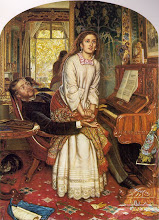
Today is the feast day of Saint Mary Magdalene, apostle and penitent. She is mentioned by name in all the gospels, and is identified as the woman from whom Christ cast seven demons. In the sixth century, however, Pope Saint Gregory the Great conflated Mary of Magdala with the nameless woman who washed Christ's feet with her tears (Luke 7:36-50), and with Mary of Bethany, sister of Martha and Lazarus (Luke 10:38-42 and John 11), giving the Church a powerful figure of repentance and spiritual renewal: at once a reformed prostitute; one of the very few who stayed with Christ at the Crucifixion; in her identification with Mary of Bethany, the first contemplative; and, as the first witness to the Resurrection, apostola apostolorum, the Apostle to the Apostles. In the Middle Ages, Mary Magdalene came to be identified also with the Samaritan woman, living in sin with her sixth "husband," who Christ asks for a drink of water (John 4:1-42), and with the woman taken in adultery (John 8:1-11).
Nonetheless, on today, her feast day, the Common of Virgins is read. It was believed in the Middle Ages, when there was a strong popluar devotion to the Magdalene, that after her conversion her virginity had been restored; indeed, she was even called "Our Lady Magdalene." Mary Magdalene's ethos is reversal: she embodies not only the miraculous transit from great sin to great sanctity, but also the mysterious paradox of Christianity itself, whereby one state can be transformed by the grace of God into its complete opposite. As Christ says in John 16:20, "Amen, amen, I say to you, you will weep and mourn, while the world rejoices; you will grieve, but your grief will become joy."
May Saint Mary Magdalene intercede for us all.











6 comments:
While it's interesting to speculate about the conflation of all the different Marys and unnamed women in the New Testament, I have always thought that something was lost with the meshing of so many different--and interesting--female perspectives into one. Particularly when you consider that that one has so often been the subject of a lot of sensationalist speculation.
I've always felt a very strong draw towards Mary of Bethany, and an equally strong impatience with the need to separate her story from that of all the other "Magdalenes" with which she's been identified.
I've seen many compelling explorations of the possible reasons for Pope Gregory's combination of all of these female characters, however in the current Da Vinci Code-heavy climate, maybe a bit of back-tracking is in order on this one.
That painting is great--tell me something about it. I gather from the filename it's by Latour, a name I only vaguely recognize. Is there some kind of story implied, or is the viewer just invited to supply his own?
That painting is actually in the Met, and as a bit of trivia: I was actually photographed as that painting for a friend's photography assignment in a Parsons class (assignment being to compose a photo of a well-known painting). It's one of my favorites. Julia, any more about the painting?
Hala, there is a similar Magdalene painting at the Met, but this one is actually at the Los Angeles County Museum of Art. They're both by Georges de la Tour and were painted in the 1640s (he has a few others in his series of penitent Magdalenes too). The Magdalene has traditionally been depicted in the West in red and white clothing, colors that show her transition from a life of passion (and sin) to one of contemplation (and holiness). The skull and the flickering flame show that she has turned away from frivolity and is contemplating the last things. De la Tour was a master at painting interiors in which candlelight is the only source of light.
Actually, the Church reversed the Gregorian conflation of Mary of Magdalene with Mary of Bethany and the penitent sinner in 1969, but the figure of the penitent Magalene is imprinted quite strongly in the cultural imagination of the West. I have heard that the Eastern Church kept these three women separate, but I'm not sure about that. Do you know?
Is that Da Vinci Code Magdalene thing still out there in the culture? If so, it's a pity. I think that Pope Gregory had profound wisdom in making this identification.
Actually, the Church reversed the Gregorian conflation of Mary of Magdalene with Mary of Bethany and the penitent sinner in 1969, but the figure of the penitent Magalene is imprinted quite strongly in the cultural imagination of the West.
Hence, as a side note, the removal after 1969 of the "qui Mariam absolvisti" line from the "Dies Irae". sequence.
Wow, Fallen Sparrow, I had no idea. I think that's an unfortunate omission. Surely a woman who had seven devils cast out of her must have had an absolvable sin or two in her past that would justify keeping it in! When I read that line in your post, I heard it as Mozart wrote it for the soprano solo in his Requiem, a tremendously moving moment in the "Recordare."
Post a Comment